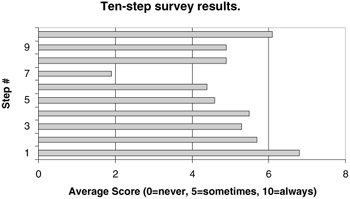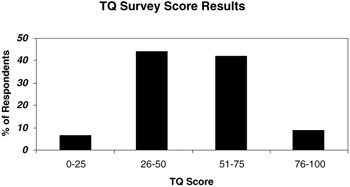Comparing Your Assessment with Others
The assessment checklist provides an easy way to initiate a discussion about your group's practices with its members. Compare how members scored individual steps. Ask everyone if they agree on the assessment and what they consider to be its significance. Participants don't always have a clear perspective on behaviors that limit their team's performance. A group self-assessment will hold up a mirror so that everyone can see.
When discussing the assessment, ask the following questions:
-
Where are our key opportunities for improvement? Discuss how the gaps between your group's current practices and those of the ten-step process limit your results or cause frustration. This discussion is even more important than your specific scores. Focus on how your current practices affect your results, then consider how the ten-step process can yield the most improvement for your group.
-
How do your scores compare with those of other organizations? You can compare your group's scores on individual steps with the results from thirty-six organizations that assessed themselves before learning and applying the ten-step process. The survey included middle managers in a wide range of organizations: manufacturing firms, service businesses, and government and educational organizations of various sizes. I focused on middle managers because they generally exhibit a healthy level of candor and are in a position to see up, down, and sideways in their organizations. The questions asked respondents to what degree their organizations already employed practices like those in the ten-step process (following the preceding self-assessment questionnaire).
When scoring the individual steps, some respondents reported scores as low as 0 or 1, while a few scored some as high as 9 or 10. Figure 19 summarizes the average score for each of the ten steps, revealing major gaps between typical organizational practices and the elements of the ten-step process.

Figure 19: Ten-step survey results.
The sums of the scores on the ten steps (TQs) for respondents ranged from a low of 22 to a high of 91 out of 100. The average was 50. Fewer than 10 percent reported significant use (a TQ score of 76 or higher) of practices similar to the ten-step process. (See Figure 20.) So while some organizations have a few of the ingredients, very few have discovered and put the full recipe to use.

Figure 20: TQ survey score results.
The TQ scores correlated closely with the respondents' assessments of their organization's performance. Those firms that more frequently and more extensively applied ten-step practices reported better success in realizing great results. (See Figure 21.) Firms with higher TQ scores also reported better use of participants' potential and more learning. You can take the survey online and compare your results with other organizations at this book's Web site, www.howgreatdecisionsgetmade.com.

Figure 21: Ten-step practices yield results.
A low TQ score is not a badge of failure—it's an opportunity for substantial improvement. By closely following the ten-step process, every business or organization can readily increase its score and produce significant and lasting results.
EAN: 2147483647
Pages: 112